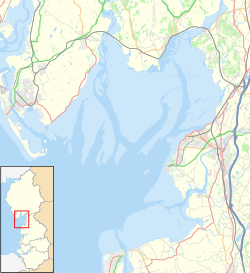History
Bardsea, or Berretseige, is mentioned in the Domesday Book as one of the townships forming the Manor of Hougun held by Earl Tostig. [1] Also once part of the medieval manor of Muchland.
Bardsea was once a small farming and fishing village well into the 19th century. It was accessed mainly by crossing the treacherous sands of Morecambe Bay. The church of Holy Trinity was consecrated in 1853. Previously the area had been included within the parish of Urswick.
The area was also associated with the early Quaker movement. When founder George Fox married local landowner Margaret Fell, he took over Swarthmoor Hall and much of the land round Bardsea. There is an old Quaker burial ground nearby at Sunbrick on Birkrigg Common, where Margaret Fell was reputedly buried in 1702 (one authority suggests she was interred at the burial ground at Swarthmoor, although that is contradicted by other sources). George Fox himself was buried in London.
When iron ore mining and production led to industrialisation in Furness, Bardsea became a significant port, with steamers leaving for Fleetwood and Liverpool. That was short-lived, however, with the Furness Railway and Ulverston Canal taking business away from the village by the end of the Victorian period.
A branch line from Plumpton Junction, on the main railway to Barrow, which opened in 1883, was supposed to run to Bardsea and beyond, but the rails never got closer than Conishead Priory, about 1 mile (1.6 km) to the north. The line closed in 1917. [2]
This page is based on this
Wikipedia article Text is available under the
CC BY-SA 4.0 license; additional terms may apply.
Images, videos and audio are available under their respective licenses.




